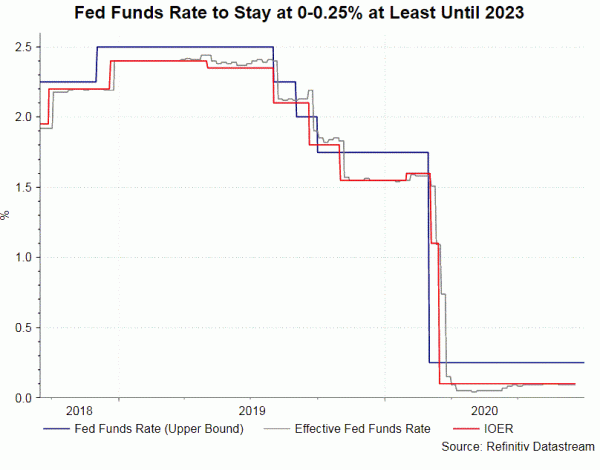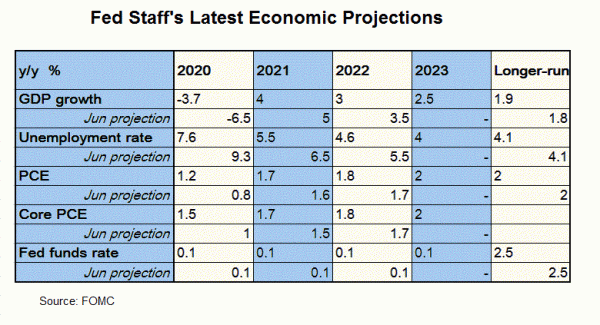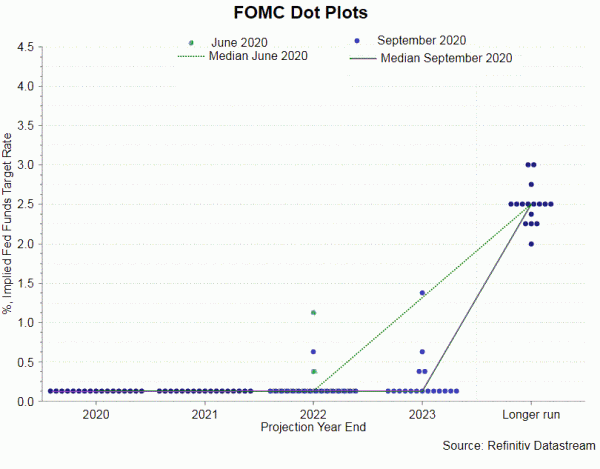The Fed left the policy rate unchanged at 0-0.25% and the asset purchases program unchanged in September. There are substantial changes in the policy statement, reflecting the formal adoption of average inflation targeting. Updated economic projections revealed a more optimistic outlook for this year through to 2022. The Fed also has also introduced economic forecast for 2023 at the meeting. On the monetary policy outlook, the median dot plot suggested that the Fed funds rate would stayed unchanged at the range of 0-0.25% at least until 2023.

The economic assessment was largely the same as the previous meeting. The major change was the acknowledgement that “economic activity and employment have picked up in recent months”. This is compared with the language that “economic activity and employment have picked up somewhat” in the July statement. Policymakers, however, reiterated that risks are skewed to the downside and are highly dependent on the health crisis. The better-than-expected economic recovery is reflected in the economic projections. GDP is expected to contract -3.7% y/y this year, compared with -6.5% projected in June. However, GDP growth forecasts in 2021 and 2022 were revised lower to +4% and +3% respectively. Forecasts on other indicators were upgraded across the board with unemployment rate lower, while headline and core inflation higher, than June’s forecasts from 2020 through to 2023.

As the Fed has formally adopted the monetary policy framework of average inflation targeting, the language in the statement including the forward guidance was adjusted accordingly. The statement indicated that “the Committee seeks to achieve maximum employment and inflation at the rate of 2% over the longer run. With inflation running persistently below this longer run goal, the Committee will aim to achieve inflation moderately above 2% for some time so that inflation averages 2% over time and longer-term inflation expectations remain well anchored at 2%”. It added that “the Committee expects to maintain an accommodative stance of monetary policy until these outcomes are achieved”. On the forward guidance, the central bank “decided to keep the target range for the federal funds rate at 0 to 1/4% and expects it will be appropriate to maintain this target range until labor market conditions have reached levels consistent with the Committee’s assessments of maximum employment and inflation has risen to 2% and is on track to moderately exceed 2% for some time. This marks a significant change from previous meetings which emphasized the “maximum employment objective and its symmetric 2% inflation objective”. Moreover, the Fed previously pledged to maintain the policy rate “until it is confident that the economy has weathered recent events and is on track to achieve its maximum employment and price stability goals”. While not explicit enough (the Fed has not stated the numeric target of “exceed 2%”), the forward guidance in September has been shifted to an outcome-based one.
The guidance on asset purchases was largely unchanged, though. The Fed only noted that it would increase holdings at their current pace to “sustain smooth market functioning and help foster accommodative financial conditions”. There was no change in the composition of purchases, too.
On the monetary policy outlook, the median dot plot suggested that the Fed funds rate would stayed unchanged at the range of 0-0.25% at least until 2023. The chart shows that the members unanimously agree to keep the rate unchanged this year and in 2021. There is also more consensus about keeping it unchanged in 2022 with only one projecting a hike that year compared with two in June’s dot plot. Only four out of 17 members forecast rate hikes for the year if 2023.

Dissenters reappeared for the first time since March 15. Minneapolis Fed President Neel Kashkari dissented as he preferred to stay on hold until 2% inflation has been reached on a sustained basis, rather than aiming “to achieve inflation moderately above 2% for some time”. Dallas Fed President Robert Kaplan, dissented as he believed that “it will be appropriate to maintain the current target range until the Committee is confident that the economy has weathered recent events and is on track to achieve its maximum employment and price stability goals as articulated in its new policy strategy statement”.


 Signal2forex.com - Best Forex robots and signals
Signal2forex.com - Best Forex robots and signals




